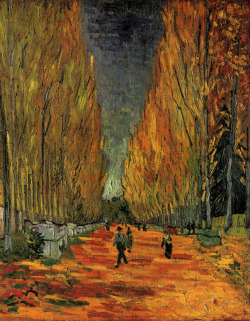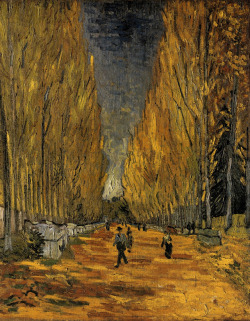Science
Related: About this forumWas Vincent van Gogh Color Blind? It Sure Looks Like It
Around a tenth of all men are color blind or color deficient, and as Joe Hanson discusses on It’s Okay to Be Smart, famed painter Vincent van Gogh may have been counted among them.
Hanson references the work of Kazunori Asada, a researcher and designer who is concerned with color vision. Asada had seen some of van Gogh’s work in what he calls a color vision experience room – one where the lighting conditions are meant to simulate color blindness.
However, in the van Gogh images seen in the color vision experience room, to me the incongruity of color and roughness of line had quietly disappeared. And each picture had changed into one of brilliance with very delicate lines and shades. This was truly wonderful experience.


(original and simulated colorblind)
more
http://blogs.smithsonianmag.com/smartnews/2012/08/was-vincent-van-gogh-color-blind-it-sure-looks-like-it/
navarth
(5,927 posts)Makes me want to read Lust For Life and The Letters Of Vincent Van Gogh all over again.
bmbmd
(3,088 posts)i might point out that the two images are identical to me.
I know very well I'm colorblind. Looks just alike.
dipsydoodle
(42,239 posts)Last edited Fri Aug 24, 2012, 05:37 PM - Edit history (1)
are you saying you couldn't copy a colour you were looking at with paint or pick it out from a colour chart used as a reference guide. ?
bmbmd
(3,088 posts)I only wear black socks and blue socks, and I have terrible difficulties with shades. As an example, I only see two colors in a rainbow-blue and yellow.
dipsydoodle
(42,239 posts)Helps me understand better. There's an interaction between hue and luminance. Dark blue in poor light would look black : its interesting you are able to differ between blue and black.
![]()
felix_numinous
(5,198 posts)of altered eyesight gave the world such a gift of color. Like Monet's impressionism being a record of his myopia.
I've always wondered just how diverse human beings are in the way we perceive the world, though we may be using the same language to describe it.
![]()
TalkingDog
(9,001 posts)Last edited Thu Aug 23, 2012, 08:56 AM - Edit history (1)
He didn't have Myopia in any way shape or form.
There are always badly formed theories by "scientists" who have no conception of what it takes to Master the art and craft of painting. Or seemingly, why artists make the creative choices they do.
In science, parameters are set by the scientific method. You have to play the hand you are given when dealing with materials, effects, processes. (...supposedly. Though if you read any history regarding science you'll find them to be as small minded, territorial and fundamentalist as any other group of people and hence very prone to "affecting" the outcome of their experiments), but artists are under no such constraints. Their job is to break the rules or play with new ones while maintaining a set of self imposed parameters.
A scientist can't just make up the outcome he wants (though many do), but that is exactly what the artist does. -I want to make a painting using mostly yellow and red and I'll use that field I saw last week as a template.- An artist works out the outcome, then experiments with how to get there. A scientist devises an experiment to see where it leads.
Rather than trying to "demysitify" art by stripping the artists of their Mastery due to some random physical circumstance, why don't scientist actually learn what artists think and do before publishing such trivial nonsense?
dipsydoodle
(42,239 posts)by the fact he could taste colour.
AlbertCat
(17,505 posts)All you have to do is look at his paintings in chronological order.... or at least the different phases he goes thru.
His early paintings are very grey and brown...

and the colors develop into a blue/ green almost pastel phase....

and later into a bold phase...


You'll also notice the brushwork doesn't start out bold and scattered.
The man was NOT colorblind.
On the Road
(20,783 posts)The assumption behind the study seems to be that the incongruity in Van Gogh's paintings is unintentional.
Of the two pictures above, the one on the right certainly looks smoother. However, IMO the real one is superior because of the more contrasting colors.
1monster
(11,012 posts)someone who was myopic, being severly so myself. The softened lines created by the short focus of near sightedness can be quite beautiful at times, even if quite inconvenient. The faerie lights we use on Christmas trees spread out to about an inch and a half diameter of soft starlight like light (exactly like the stars in the second "blue" painting in your post).
AlbertCat
(17,505 posts)I'm myopic like crazy.... with astigmatism.
But I think Impressionism's "fuzziness" comes from painting outdoors, very fast, to catch the light.
Also Cezanne does a seemingly mundane thing but that really makes a difference: He uses the actual brushstrokes to define the image. Like the strokes on a roof will follow the roof line. The brushstrokes follow the contour of the crumpled cloth. Now it's more than just the placement of pigment that defines the image, but also how the pigment was applied.
I know.... too much art history! ![]()
TalkingDog
(9,001 posts)If he were color deficient, then he would've used color more "haphazardly". In other words where he was using a yellow orange in the painting above, he may have added a yellow green (for the sake of argument) in random places without realizing they were different colors.
I've taught color deficient student and know of one instance (related to me by a former teacher of mine) where the artist was painting abstractly and would throw in random patches of hot pinks and lime greens in an otherwise muted field of color. When asked by my teacher why he was doing that, the artist had no clue what my teacher was talking about.
So, no. It's very highly unlikely that he used color in such a controlled manner and was in any way color deficient.
JDPriestly
(57,936 posts)same colors and to the same degree?
Isn't there red/green v. blue/green colorblindness?
TalkingDog
(9,001 posts)and like anything inherited, can range from very mild manifestation to the complete inability to distinguish anything in that color range.
There is a complete inability to distinguish any color variation; in other words seeing in only shades of grey. (however, not 50... bad pun) But that is not the same thing as color deficiency.
Here is a really good site by a person who is color deficient. It has a lot of good information:
http://wearecolorblind.com/ In the upper right corner there is a little app that simulates the different forms of color blindness. Try it. Now imagine trying to use tints, shades and variations of the colors you "can't" see to color a painting or even a coloring book.

The three types of cones translate into three main types of colorblindness: Deuteran (green), Protan (red) and Tritan (blue) (and mixtures thereof, because you can have deficiencies in more than one color)

Imagine trying to paint the flower with some kind of underlying cohesion to your color scheme when you can only see the colors present on your palette in the shades from the other images. It would be like driving the Indy 500 in the fog with cheesecloth draped across your eyes. In other words, if you couldn't distinguish one or more colors with any degree of certainty, you would definitely not have such tight control over the nuance and range of colors used.
One of the assignments I give students is to copy a Master Work. Van Gogh pops up all the time as an option. If his color schemes and paint mixtures were simple, they would have less trouble reproducing them.
I usually discover my color deficient students when we start working with the color wheel or color mixing or in color theory. It becomes evident pretty quickly that they have trouble distinguishing colors that other people have no problems with.
Thank you for the thoughtful and open question.
JDPriestly
(57,936 posts)TalkingDog
(9,001 posts)thanks.
Vestigial_Sister
(182 posts)Vincent had no intention of producing a dung-colored and lifeless painting as that exhibited on the right.
Motown_Johnny
(22,308 posts)even after reading the posts here which contradict the finding.
I need more evidence than just a couple paintings though.